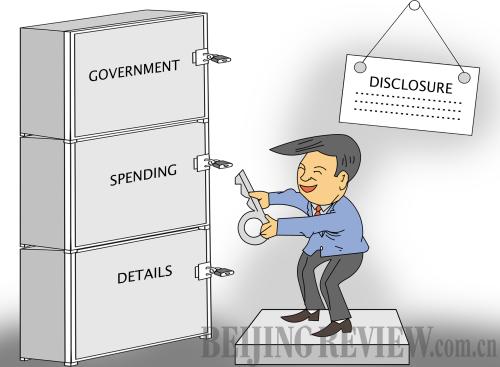|
 |
|
(LI SHIGONG) |
How much does it cost to have the annual session of the National Committee of the Chinese People's Political Consultative Conference (CPPCC), the top political advisory body? For the first time, the answer was given to the public: About 59 million yuan ($9 million) in 2010.
The unprecedented expenditure disclosure came after a journalist raised a question about spending with Zhao Qizheng, spokesman of this year's session of the CPPCC National Committee, at a press conference on March 2.
Though Zhao couldn't give an immediate answer, he said, "Please allow me to ask my colleagues and send you an e-mail or text message afterward." The journalist got the answer from the News Office of the CPPCC National Committee.
It was the first time such spending figures have been released to the public. The 59-million-yuan figure is mainly money spent on the 2,237 CPPCC National Committee members, workers at the session and hotel stays during the 10-day event, said the news office.
"It's news to me that the cost was made public. But, it's progress to make it transparent. The public has the right to know how much money was spent and what it was spent on," said Zhao Shuyue, a CPPCC National Committee member. He said it's an effective way to prove the grand meeting of political advisors isn't wasting money and that it welcomes public scrutiny.
Since the CPPCC National Committee has taken the lead in disclosing accounts of its spending, lawmakers are also calling for the government's expenditure to be disclosed in detail as the government vows to make its financial information more accessible to the public this year.
"The public not only needs to know the government's budget plans, but more importantly, they need to know how much the government actually spends, as well as what things and purposes that money is put toward," said Chen Shu, a deputy to the 11th National People's Congress (NPC), China's top legislature.
Premier Wen Jiabao also said in his government work report to this year's NPC session the government would speed up its attempts to make the budgetary plans public. Many NPC deputies saw his remarks as indicating the government's determination to become more transparent.
A meeting of the State Council decided in late March the Central Government would report the final spending accounts to the NPC in June, and make the accounts available for public supervision. Most importantly, the report will include three big items of government spending—officials' overseas trips, the procurement and maintenance of government cars and the fees for official receptions. They are estimated to cost taxpayers 900 billion yuan ($132 billion) a year, which represents about 30 percent of the total government expenditure.
China's curbing on extravagant spending by officials saved the country 5.7 billion yuan ($863 million) last year, said Wu Yuliang, Secretary General of the Central Commission for Discipline Inspection of the Communist Party of China.
Trying to be open
In early April, several ministries began to release their budgets for the year, answering the call of the Central Government for government departments at all levels to take initiatives to publicize their budget information, and it was the second time they had done so since 2010.
The Ministry of Finance posted its budget plan for the year on April 1 on its official website, a document containing more detailed information than was released in 2010. One of its balance sheets included in the budget disclosure shows the ministry plans to spend 2.6 billion yuan ($395 million) in 2011, up 6 percent from the past year.
The State Food and Drug Administration revealed its budget plan of 805 million yuan ($118 million) this year on April 2. But, the disclosure gave fewer details than what was given out by the Ministry of Finance.
The go-transparency initiative is not just a concern of the Central Government but also local authorities. Various departments of the municipal government of Beijing have actively set out to release budgets with details. They have publicized information about spending 40 million yuan ($5.8 million) on new official vehicles this year.
As early as in 2009, the municipal government of Guangzhou, capital of south China's Guangdong Province, released its annual accounts on the Internet for the first time. The public could download the 2009 Guangzhou Municipal Department Budget from the website of the Guangzhou Finance Bureau. The document contains detailed budgets of 114 municipal government departments.
| 